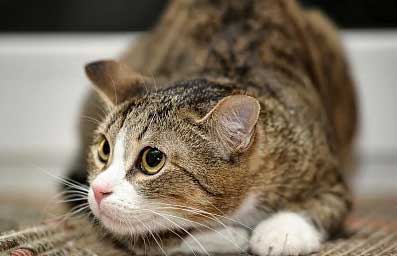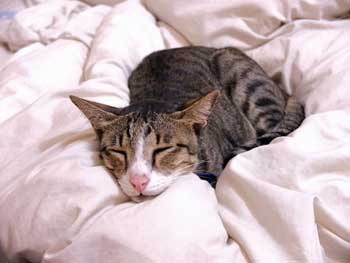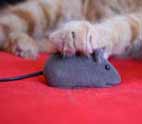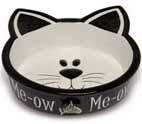Pain Relief For Cats - The Facts
Pain relief for cats is a subject that many caring cat owners worry about a lot!
We all hate the idea of our beloved pet suffering in pain or discomfort, but let me start this information with a warning:
We can cause more harm than good if we try to help relieve a cat in pain if we don't know what we are doing!
For example, it is important that we never give our cats medication that we would take for pain relief ourselves.
A cat's liver does not function the same as ours and this means that medication meant for humans can remain in the cat's body for longer, causing liver or kidney damage and even death.
So only ever give medication that is specifically made for pain relief for cats and prescribed by a qualified vet.
On This Page:
- How Do You Know If Your Cat Is In Pain?
- Symptoms of Pain in Cats
- Drugs For Pain Relief For Cats
- Alternative Therapies for a Cat in Pain
How Do You Know If Your Cat Is In Pain?

Unfortunately, cats are very good at covering up their pain and discomfort.
They can carry on looking and behaving as normal for quite some time before it becomes obvious to their owner that something could be wrong.
It is important therefore that you monitor your cat's health regularly.
Take notice of their normal toilet and eating habits and regularly check the condition of their eyes, teeth and claws. Comb their fur and look for things like ticks, scabs, cuts and wounds.
Symptoms Indicating A Cat In Pain Include:
- Your cat might become less social and want to be left alone. They may start to hide under furniture and no longer want to be stroked or picked up.
- They might have difficulty moving or cry out when touched. They might hiss or scratch as a warning when approached.
- A loss of appetite is also a good indication that something may be wrong. However this may be confused with a cat who just wants a change of food which is not unusual. So a reluctance to eat should be monitored for a few days to see if there are other symptoms.
- Lethargy and an unwillingness to move around could also mean that the cat is in some discomfort and that movement makes it worse.
- Rapid breathing and or swallowing hard is also something to watch out for. Heart conditions and respiratory infections can also be reasons for these symptoms.
- Cats may also start to groom themselves excessively when they are either anxious or in some pain. They might groom the same area over and over again, often causing bald patches to occur.
If you are worried that your cat is showing symptoms like these, or appears to be unwell in any other way, then please get them to see a vet for an examination and proper diagnosis.
Pain Relief For Cats
After Surgery
Vets will administer pain killers after surgery. This is normally in the form of an injection which contains a pain relieving drug which lasts for several days.
If after this time the owner feels that the cat is still in pain, the vet can prescribe tablets for home administering, however they must be used in the short term only as they may have side effects if used for longer.
A vet has to make lots of decisions about what is right for the particular cat and their overall health condition to ascertain which pain relieving drugs are suitable.
General Pain Relief Drugs For Cats

Some of the drugs used by vets for pain relief for cats are:
- Tramadol - an opiate like drug often used for moderate to severe pain
- Metacam - contains Meloxicam, a non-steroidal anti inflammatory drug for short term use
- Fentanyl Patch - for controlling post-surgical pain
- Prednisone - also has anti-inflammatory properties
All of these drugs can have side effects which the vet will discuss with you and some should not be used in conjunction with other medications such as flea treatments.
The vet will advise the owner of these concerns at the time of prescription and is another good reason why only prescribed pain relief should be given to your cat.
For example, I recently had Meloxicam prescribed for my Byron (as well as antibiotics) after he had a wound cleaned and dressed at the vets following a cat fight. The Meloxicam came in the form of Metacam oral solution and I found it really easy to administer. All I had to do was draw up the prescribed dose in a little syringe and squeeze the liquid pain killer into his mouth.
Luckily Byron didn't even seem to mind the taste. It was only needed short term and it certainly appeared to help ease the amount of discomfort he was in.
Alternative Cat Pain Relief
Some cat owners may prefer to choose alternative therapies for pain relief for cats.
Of course this decision should always be discussed with a qualified vet to consider all the options and decide what is best for the animal's welfare.
I have found though that many good vets are happy to explore complementary therapies as well as conventional medicine or surgery.
Some of the possible alternatives are:
- Magnetic therapy - The use of magnets in specially designed fitted collars is the usual way for this to be administered.
- Acupuncture - This could be useful in long term chronic pain in cats. A qualified feline acupuncture therapist would have to be found to administer the treatment, which would have to be undertaken regularly.
- Homeopathy and herbal remedies - These remedies are more common for cats than they used to be and are available through online companies such as Pet Wellbeing. Some vets also prescribe some homeopathic treatments. Usually these treatments have to be taken over a period of time to provide pain relief.
- Massage therapy - This is often used in conjunction with heat pads which can be prescribed for use at home.
So there are options available for effective pain relief for cats!
The main point though is the importance of getting treatment prescribed by a qualified vet following a proper examination and diagnosis.
Top of this Pain relief For Cats Page






